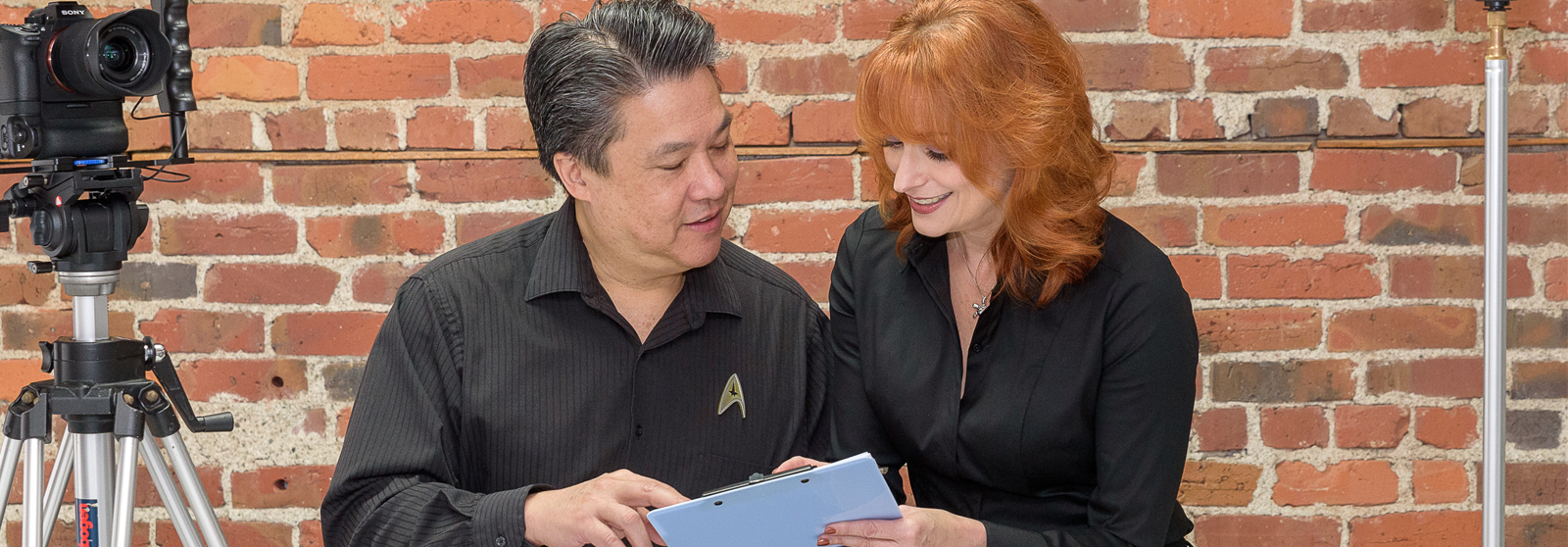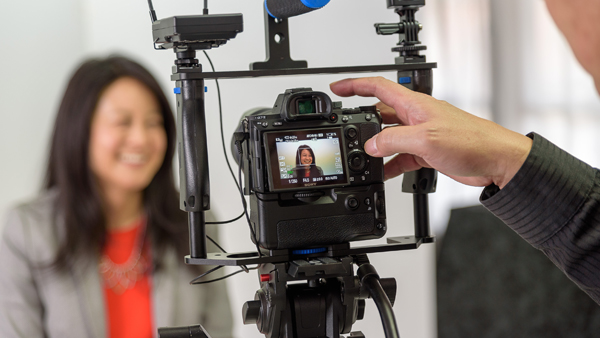What to Expect When You’re Expecting a Videographer: Overview and Pre-Production

So here’s a question I get asked a lot: “If I hire you to do my video, what should I expect?” Video production is a foreign world to most people, whose concept of it tends toward two extremes: DIY social media posts shot on a smart phone; or major studio sets complete with jibs, dollies, booms and other alien-sounding tech, with a director yelling “Action!” through a megaphone. Most video production for business lives somewhere between these extremes.
Many clients worry that producing a video is going to take up a lot of their time, and that they’ll have to do the planning and organizing themselves, as well as deciding what to say, where to stand, what shots to get, and more. It can be stressful just thinking about it.
The reality is that the best – and least-stress-inducing – video projects result from detailed pre-production that your videography company handles for you. Pre-production, by the way, refers to all the planning and organization that happens BEFORE the day of the shoot.
Speaking of video jargon: When I joined the world of video production back in 2009, even though I brought 20 years of event production to the game, I had zero familiarity with video. I was like most of you reading this article: I didn’t know what “pre-production” was, let alone jibs, booms, white balance, or the temperature of light. After ten years of immersion in the craft, I feel a unique ability, nay, a compulsion, to explain it to non-video people in a comprehensible, non-technical way. I do this so that you can interact with your videographer in a knowledgeable manner, spending just as much time and concentration as you need to get your project completed on time and on budget. And that starts with knowing what to expect.
As I describe what to expect when you hire a videographer, I’m going to use as an example a typical project that is important for most businesses: the “About Us” video that headlines their website. These are usually about 2 minutes long; involve an interview with one or more company members and sometimes clients; and some b-roll, that is, additional video footage to add visual interest. Other types of projects (event highlights, promo videos, speaker demos, etc.) will involve similar elements as described below, with slight variations.
Overview of the Video Process
The “Executive Summary” answer to the question “what to expect when you’re working with a video company” goes like this:
- Depending on the complexity of your video, you should expect to spend at least 20-30 minutes discussing your goals for your video project with the videographer BEFORE you get a proposal.
- Once the contract is signed, expect a second phone conference and possibly a site visit before the shoot.
- From those meetings, your videographer will compile shot lists, interview questions, etc. that you will need to review (but usually not have to create yourself) and approve before the day of the shoot.
- On the day of the shoot, plan to set aside 4-8 hours. Your videographer will tell you what they think is the best amount of time based on the vision for your video.
- After the shoot, expect to wait at least 2 weeks before seeing your first draft – unless otherwise arranged – for reasons I’ll discuss later in this article.
- Once the first draft is sent to you, you’ll want to view it several times (it’s only 2 minutes, after all!), and share it with colleagues for review. Then send your edits, if any, to your videographer.
- Shortly after that, you’ll get your proof copy. If it’s good to go, your part is almost done! Wait for your file or finalized YouTube link to arrive, send it off to your webmaster and voila! You have a brand-new showpiece video for your website and social media.
For those that crave more details about the process, here you go.
Let’s start with some basic definitions.
- Pre-Production: Everything that happens to organize the video projects prior to filming.*
- Production: Filming on site, both of interview(s) and of b-roll, that is, visuals that will support the narrative of the video. Also called “the shoot.”
- Post-Production**: Editing phase. Starts once all video and audio elements have been captured.
*Almost no one shoots with actual film anymore – and they’d charge exponentially more if they did – but “digital video recording” is quite a mouthful, so I’ll use “filming” for the rest of this article as shorthand for “digital video recording” or the even more jargon-y “video capture.”
**Many videographers cheerfully intermix the use of the term “Production” to describe EITHER the filming part, OR the entirety of “pre-, filming, and post-”, depending on how granular they’re getting, so if you’re confused, ask for clarification.
Pre-production
So what specifically happens in pre-production?
As I mentioned earlier, pre-production starts with determining what the parameters of the video will be. These are all the things you want figured out BEFORE the day of your shoot. A thorough videographer will discuss with you several or all of these items – my list is not comprehensive, but it’s a good start. Pre-production takes place after a video production agreement has been signed. You’ll have input on most of these steps, but the videographer is going to be doing the bulk of the work.
- Review Goal, Audience, and Format – these should have been covered in the proposal phase, but a good videographer will review them at the start of pre-production:
- Goal: What is the goal of your video? What message are you trying to get across, or what action do you want viewers to take after seeing it?
- Audience: Is the video for potential or existing clients? Potential or existing employees? What are the general demographics of that target audience?
- Format: Will you, the business owner, be on camera and if yes, will the video be conducted interview style, in which your answers will be somewhat spontaneous (non-scripted); or, do you want to use a prompter to deliver a specific, carefully crafted message? If you choose interview format, what are the talking points you want to be sure to address? From this list, your videographer can create a series of questions they will ask (usually off-camera) to elicit those answers from you at the shoot.
- Testimonials: Do you want to include client testimonials? If so, how many, and how will that affect your choice of a shoot date?
- Site Visit: If time and budget allow, most videos benefit from your video team visiting the location where the shoot will take place before it occurs. That way they can determine the best possible shots, lighting needs, and other video-centric details.
- B-roll to capture: “B-roll” refers to the visuals that go along with the narrative. B-roll can be anything from artistic shots of your products or space to those classic staged shots of business people on their computers or phones, or greeting clients (or friends playing clients).
- Schedule: Along with the site visit and shoot date (and often an alternate shoot date, especially if there’s any outside filming planned), your videographer should prepare for you a list of target dates for submission of the first draft after filming, how much time you have to turn around edits, and how soon after the edits you should see your final video.
- Voiceover: Think of every documentary you’ve ever seen while listening to a narrator explain what your seeing – that narration is a voiceover. In pre-production, you’ll decide if your video is going to incorporate a voiceover, that is, an audio recording of a professional talent – or you – reading specific verbiage but not appearing on camera.
- Creation of an outline, sides, or storyboard by your videographer. Which of these is used depends on the complexity of the video, and how much planning can be done:
- An outline is a general plan, leaving a lot of room for flexibility depending on what is actually captured the day of the shoot. Outlines work great for live events or interviews.
- “Sides” are a list of what the narrative will be and what specific visuals that go with each line. Sides work well when talking points have been well-defined before the shoot.
- “Storyboards” look a lot like a comic book, illustrating the action in the video and the dialogue, and are primarily used for videos with actors – and a LOT of staff, including a graphic artist.
- Compile shot list: From the outline or sides, your videographer will determine what specific shots to capture, from what angles, and if any shots need to be staged.
- Gather materials: Collect logos, photos to incorporate, any branding specifics such as fonts or colors to use in graphics.
- Music: Determine if there will be a music bed, and discuss preferences. Specific music can either be determined before editing begins – as is usually the case for a video that is cut to music, such as an event highlights reel; or after the editor makes a first draft and is familiar with the pacing of the speaker’s voices.
- Outtakes: do you want to include outtakes in your video? Also known as bloopers, these are usually shown at the end of the video.
- Shoot schedule: from the information compiled in pre-production, your videographer will recommend a particular shoot schedule, that is, overall start and end time, as well as how much time is needed for set-up, and the order in which interviews and b-roll will be shot. Fun fact: it generally takes several hours to shoot everything needed for a polished 2-minute video. Sometimes it even takes more than one day, if the shooting takes place at multiple locations. So when your videographer says, “we need six hours to shoot this 90 second video,” don’t be surprised.
Stay tuned for Part 2: Production and Pre-Production
Just like videos, blogs have an optimal length for holding the attention of most readers. To avoid exceeding that, I’ve split this blog into two parts. Stay tuned for Part 2: Production and Pre-Production, coming to magnusmediavideo.com next week.
Questions? Comments? Please post below.












